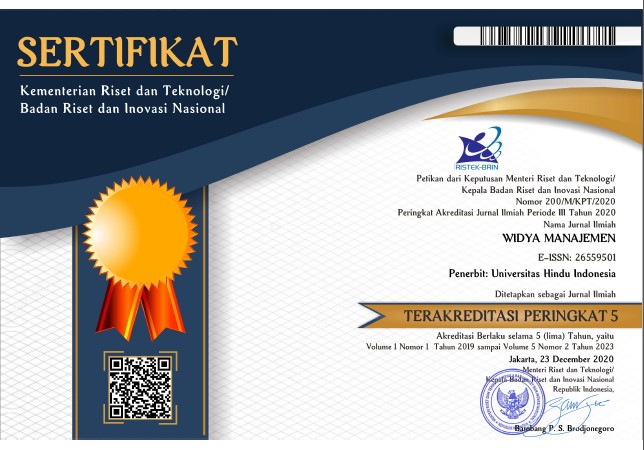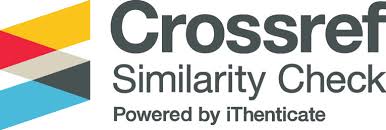Pengaruh Kepuasan Pelanggan Terhadap Kepercayaan Merek, Loyalitas Merek dan Ekuitas Merek Marugame Udon
Abstract
This study aimed to determine the effect of customer satisfaction on brand trust, brand loyalty, and brand equity. The population in this study are Marugame Udon customers in the Greater Jakarta area. The sampling technique used in this study was purposive sampling, namely customers who had made purchases more than twice so 201 people were obtained as samples. The analytical method uses a structural equation model with the help of smartPLS 3. The results show that of the seven hypotheses in this study, all of the results show acceptable results. The result is that customer satisfaction has a direct effect on brand trust. Customer satisfaction has a direct influence on customer loyalty. Customer satisfaction has an impact on brand equity. Indirect results also show that customer satisfaction has an indirect effect on brand loyalty through brand trust and customer satisfaction has an effect on brand equity through brand loyalty.
References
Aaker, D. (2009). Managing brand equity: Capitalizing on the value of a brand name. Simon and Schuster.
Aaker, D. A. (1991). Managing Brand Equity. In (Vol. 4, Issue 1).
Akhtar, N., Ahmed, I., Jafar, H. Y., Rizwan, a L. I., & Nawaz, J. M. (2016). The Impact of Packaging, Price and Brand Awareness on Brand Loyalty: A Reseller Perspective in Mobile Sector of Pakistan. International Review of Management and Business Research, 5(3), 790–807.
Ambarwati, I. A. T., Kawiana, I. G. P., & Mahayasa, I. G. A. (2022). Mediasi Kepuasan Konsumen Pada Hubungan Kualitas Pelayanan Dengan Loyalitas Pada PT Prisma Elektrika Bali. WidyaAmrita: Jurnal Manajemen, Kewirausahaan dan Pariwisata, 2(3), 832-843.
Amine, A. (1998). Consumer s’ true brand loyalty: The central role of commitment. Journal of Strategic Marketing, 6(4), 305–319. https://doi.org/10.1080/096525498346577
Angelova, B., & Zekiri, J. (2011). Measuring Customer Satisfaction with Service Quality Using American Customer Satisfaction Model (ACSI Model). International Journal of Academic Research in Business and Social Sciences, 1(3), 27. https://doi.org/10.6007/ijarbss.v1i2.35
Azize, ?., Cemal, Z., & Hakan, K. (2012). Does Brand Communication Increase Brand Trust? The Empirical Research on Global Mobile Phone Brands. Procedia - Social and Behavioral Sciences, 58, 1361–1369. https://doi.org/10.1016/j.sbspro.2012.09.1120
Baumeister, S., Nyrhinen, J., Kemppainen, T., & Wilska, T. A. (2022). Does airlines’ eco-friendliness matter? Customer satisfaction towards an environmentally responsible airline. Transport Policy, 128(May 2021), 89–97. https://doi.org/10.1016/j.tranpol.2022.09.016
Cardoso, A., Gabriel, M., Figueiredo, J., Oliveira, I., Rêgo, R., Silva, R., Oliveira, M., & Meirinhos, G. (2022). Trust and Loyalty in Building the Brand Relationship with the Customer: Empirical Analysis in a Retail Chain in Northern Brazil. Journal of Open Innovation: Technology, Market, and Complexity, 8(3). https://doi.org/10.3390/joitmc8030109
Chaudhuri, A. (1999). Does Brand Loyalty Mediate Brand Equity Outcomes? Journal of Marketing Theory and Practice, 7(2), 136–146. https://doi.org/10.1080/10696679.1999.11501835
Chin, W. W. (1998). The partial least squares approach for structural equation modeling. Modern Methods for Business Research, January 1998, 295–336.
Cobb-Walgren, C. J., Ruble, C. A., & Donthu, N. (1995). Brand equity, brand preference, and purchase intent. Journal of Advertising, 24(3), 25–40. https://doi.org/10.1080/00913367.1995.10673481
Cronbach, L. J. (1951). Coefficient alpha and the internal structure of tests. Psychometrika, 16(3), 297–334. https://doi.org/10.1007/BF02310555
Ebrahim, R. S. (2020). The Role of Trust in Understanding the Impact of Social Media Marketing on Brand Equity and Brand Loyalty. Journal of Relationship Marketing, 19(4), 287–308. https://doi.org/10.1080/15332667.2019.1705742
Faircloth, J. B., Capella, L. M., & Alford, B. L. (2001). The Effect of Brand Attitude and Brand Image on Brand Equity. Journal of Marketing Theory and Practice, 9(3), 61–75. https://doi.org/10.1080/10696679.2001.11501897
Fornell, C., & Larcker, D. F. (1981). Evaluating Structural Equation Models with Unobservable Variables and Measurement Error. 66(December), 37–39.
Fornell, C., & Larcker, D. (1981). Fornell, C. and Larcker, D.F. (1981), “Evaluating structural equation models with unobservable variables and.pdf. Journal of Marketing Research, XVIII(February), 39–50.
Henseler, J., Ringle, C. M., & Sinkovics, R. R. (2009). The use of partial least squares path modeling in international marketing. Advances in International Marketing, 20(January), 277–319. https://doi.org/10.1108/S1474-7979(2009)0000020014
Husain, R., Paul, J., & Koles, B. (2022). The role of brand experience, brand resonance and brand trust in luxury consumption. Journal of Retailing and Consumer Services, 66(December 2021), 102895. https://doi.org/10.1016/j.jretconser.2021.102895
Kim, W. G., Lee, S., & Lee, H. Y. (2007). Journal of Quality Assurance in Hospitality & Tourism Co-Branding and Brand Loyalty. Journal of Quality Assurance in Hospitality & Tourism, 8(2), 1–23. http://www.tandfonline.com/action/journalInformation?journalCode=wqah20%5Cnhttp://dx.doi.org/10.1300/J162v08n02_01
Ko, E., Kim, K. H., Kim, S. H., Li, G., Zou, P., & Zhang, H. (2009). The Relationship among Country of Origin, Brand Equity and Brand Loyalty: Comparison among USA, China and Korea. Journal of Global Academy of Marketing Science, 19(1), 47–58. https://doi.org/10.1080/12297119.2009.9707286
Kotler, P., & Pfoertsch, W. (2010). Ingredient Branding. In Suparyanto dan Rosad (2015 (Vol. 5, Issue 3).
L., R., & Oliver. (1999). Whence Consumer Loyalty? Journal of Marketing, Vol. 63(Special Issue), 33–44.
Lin, M. S., & Chung, Y. K. (2019). Understanding the impacts of corporate social responsibility and brand attributes on brand equity in the restaurant industry. Tourism Economics, 25(4), 639–658. https://doi.org/10.1177/1354816618813619
Liu, W. K., Lee, Y. S., & Hung, L. M. (2017). The interrelationships among service quality, customer satisfaction, and customer loyalty: Examination of the fast-food industry. Journal of Foodservice Business Research, 20(2), 146–162. https://doi.org/10.1080/15378020.2016.1201644
Mayer, R. C., Davis, J. H., & Schoorman, F. D. (1995). Model of Trust Theory. The Academy of Management Review, 20(3), 709–734.
Minarti, S. N., & Segoro, W. (2014). The Influence of Customer Satisfaction, Switching Cost and Trusts in a Brand on Customer Loyalty – The Survey on Student as im3 Users in Depok, Indonesia. Procedia - Social and Behavioral Sciences, 143, 1015–1019. https://doi.org/10.1016/j.sbspro.2014.07.546
Nyadzayo, M. W., & Khajehzadeh, S. (2016). The antecedents of customer loyalty: A moderated mediation model of customer relationship management quality and brand image. Journal of Retailing and Consumer Services, 30, 262–270. https://doi.org/10.1016/j.jretconser. 2016.02.002
Ostrom, A., & Iacobucci, D. (1993). Consumer Trade-Ofts and the. Oliver.
Shanahan, T., Tran, T. P., & Taylor, E. C. (2019). Getting to know you: Social media personalization as a means of enhancing brand loyalty and perceived quality. Journal of Retailing and Consumer Services, 47(January 2018), 57–65. https://doi.org/10.1016/ j.jretconser.2018.10.007
Sudaryono. (2014). ._Kepuasan Pelanggan 3.pdf.
Sugiyono. (2018). metode penelitian manajemen (setiyawami (ed.)). alfabeta.
Tjiptono, F. (2015). Kepuasan Pelanggan.Pdf.
Tuti, M., & Sulistia, V. (2022). The Customer Engagement Effect on Customer Satisfaction and Brand Trust and Its Impact on Brand Loyalty. Jurnal Manajemen Bisnis, 13(1), 1–15. https://doi.org/10.18196/mb.v13i1.12518
Wongsansukcharoen, J. (2022). Effect of community relationship management, relationship marketing orientation, customer engagement, and brand trust on brand loyalty: The case of a commercial bank in Thailand. Journal of Retailing and Consumer Services, 64(May 2021), 102826. https://doi.org/10.1016/j.jretconser.2021.102826
Zehir, C., ?ahin, A., Kitapçi, H., & Özçahin, M. (2011). The effects of brand communication and service quality in building brand loyalty through brand trust; the empirical research on global brands. Procedia - Social and Behavioral Sciences, 24, 1218–1231. https://doi.org/10.1016/j.sbspro.2011.09.142
Reproduction Policy
Every author submitting articles to Widya Manajemen must make a statement that the manuscript is free from plagiarism and is not being considered and published in other journals.
Articles that have been published are copyrighted by the Program Studi Manajemen FEBP UNHI. For educational purposes, the contents of the article may be duplicated or reproduced as long as the source of the article is mentioned. Written requests must be submitted to the editor to obtain permission to republish the contents of the article for purposes other than educational purposes.
-----------------------------------------------------------------------------------------------------
Kebijakan Reproduksi
Setiap penulis yang menyerahkan artikel ke Widya Manajemen harus membuat surat pernyataan bahwa naskahnya bebas dari plagiarisme dan tidak sedang dipertimbangkan dan dimuat dalam jurnal lain.
Artikel yang telah dipublikasi menjadi hak cipta Program Studi Manajemen FEBP UNHI. Untuk tujuan edukatif, isi dari artikel dapat digandakan atau direpublikasi selama menyebutkan sumber dari artikel tersebut. Permintaan tertulis harus diajukan kepada editor untuk memperoleh ijin merepublikasi isi dari artikel untuk tujuan lainnya selain tujuan edukatif.






.jpg)









